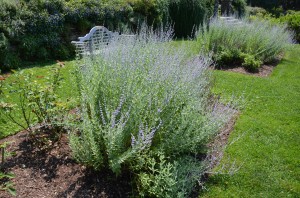Russian sage (Perovskia atriplicifolia) is low maintenance woody-based perennial. It grows in a dry to medium moist average soil and, first and foremost, in full sun. It’s a long-lived perennial which stands up to summer’s heat and humidity (USDA hardiness zones 5-9). Branches tend to flop or take on a droopy appearance in late summer. The Perennial Plant Association named Plant of the Year in 1995.
Russian sage (species) typically grows 4 to 5 feet tall and 3 to 4 feet wide if left unpruned for multiple years. Terminal panicles of light blue tubular flowers are perched on upright square stems. It blooms consistently from early July to October in the Southern Appalachian region (USDA hardiness zones 6 and 7).
The principal appeal of Russian sage is its cool blue flowers and the openness of its plant form. This member of the mint family emits a sage-like odor when the leaves are crushed. Russian sage adds structure and grayish color to the winter landscape. This tough perennial has no disease or pest problems. Deer and rabbits leave it alone and its gray-green foliage copes with urban air pollutants.
For neatness, prune back plants 3-6 inches to the ground in early spring as the new growth begins. Fertilize with 10-10-10 or equivalent in early spring or feed in spring and early summer water-soluble fertilizer such as Miracle-Gro™, Jacks™, or Daniels™.
These four compact cultivars are a better fit in a small urban garden:
‘Filigran’ – 3-4 feet tall and wide, light blue flowers and lacey silvery foliage on upright branches.
‘Lacey Blue’ – 1-1 ½ feet high by 2-3 feet wide, compact British introduction with thick stems with less “flopping”. Upright silver stems bear dense panicles of large lavender-blue flowers.
‘Little Spire’- 2-3 feet high and wide; masses of small, violet-blue flowers and dense silvery-green foliage.
‘Longin’ – 3-4 feet high and wide; deep blue flowers on stiff, upright stems.


 Posted in
Posted in 
